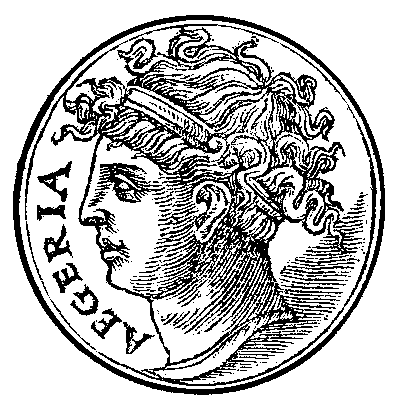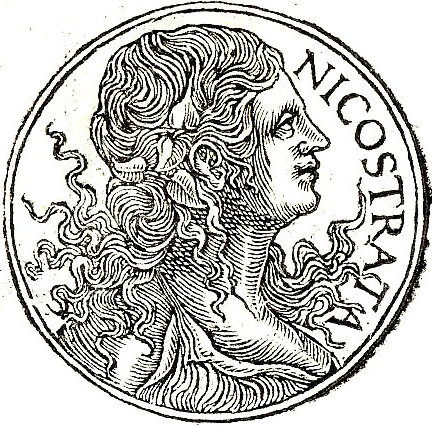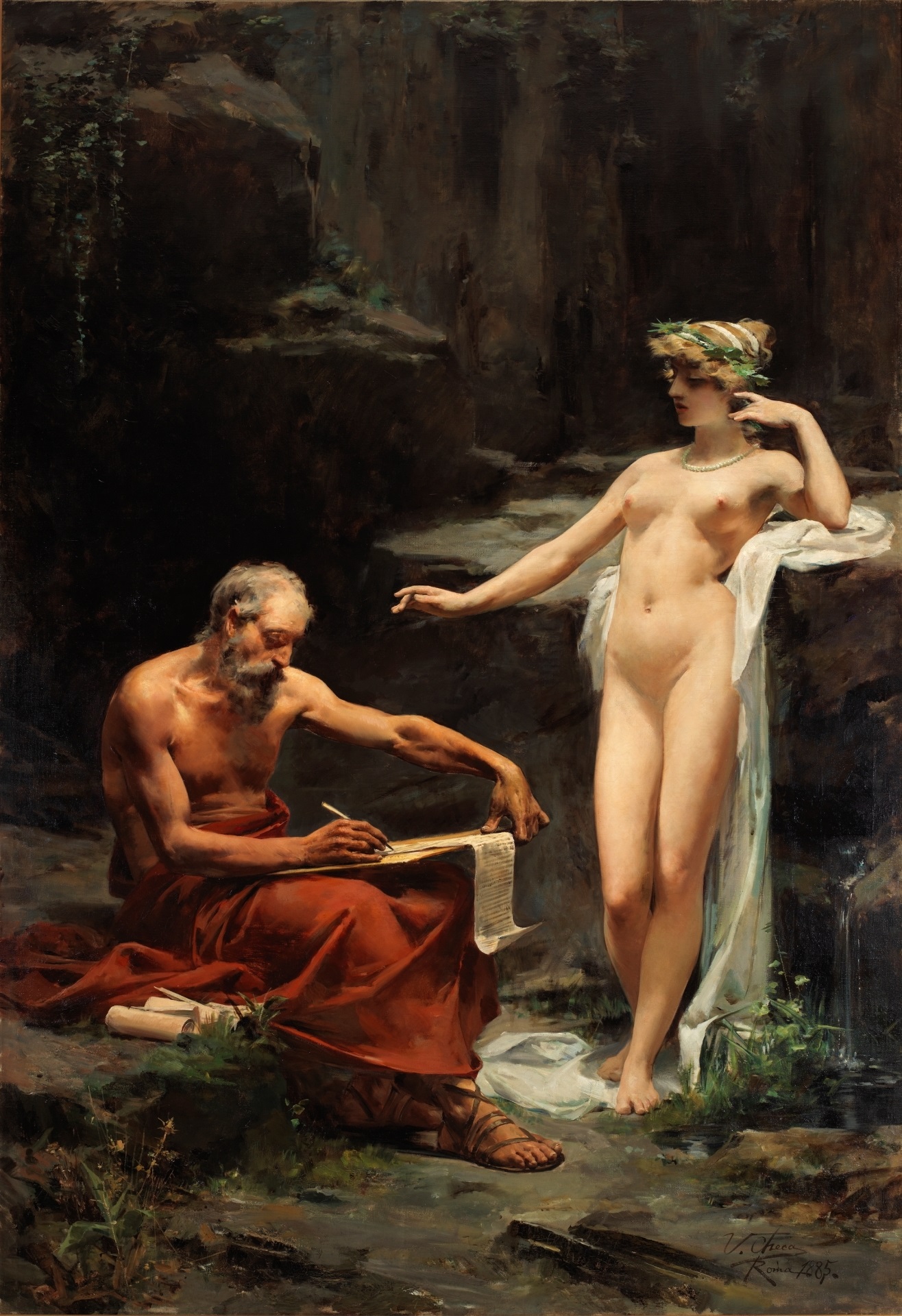|
Camenae
In Roman mythology, the Camenae (; also ''Casmenae'', ''Camoenae'') were originally goddesses of childbirth, wells and fountains, and also prophetic deities. List of Camenae There were four Camenae: *Carmenta, or Carmentis *Egeria (mythology), Egeria, or Ægeria, or Aegeria *Antevorta, or Porrima *Postverta, or Postvorta, or Prorsa The last two were sometimes specifically referred to as the Carmentae and in ancient times might have been two aspects of Carmenta rather than separate figures; in later times, however, they are distinct beings believed to protect women in labor. Carmenta was chief among the nymphs. Her festival day, the Carmentalia, featured water ritually drawn by Vestal Virgins from the spring outside the Porta Capena. The Camenae were later identified with the Greek mythology, Greek Muses; in his translation of Homer, Homer's ''Odyssey'', Livius Andronicus rendered the Greek word ''Mousa'' as ''Camena'' and Horace refers to poetic inspiration as the "soft breath o ... [...More Info...] [...Related Items...] OR: [Wikipedia] [Google] [Baidu] |
Roman Goddesses
The Roman deities most widely known today are those the Romans identified with Greek counterparts (see '' interpretatio graeca''), integrating Greek myths, iconography, and sometimes religious practices into Roman culture, including Latin literature, Roman art, and religious life as it was experienced throughout the Empire. Many of the Romans' own gods remain obscure, known only by name and sometimes function, through inscriptions and texts that are often fragmentary. This is particularly true of those gods belonging to the archaic religion of the Romans dating back to the era of kings, the so-called "religion of Numa", which was perpetuated or revived over the centuries. Some archaic deities have Italic or Etruscan counterparts, as identified both by ancient sources and by modern scholars. Throughout the Empire, the deities of peoples in the provinces were given new theological interpretations in light of functions or attributes they shared with Roman deities. An exte ... [...More Info...] [...Related Items...] OR: [Wikipedia] [Google] [Baidu] |
Carmenta
In Religion in ancient Rome, ancient Roman religion and Roman mythology, myth, Carmenta was a goddess of childbirth and prophecy, associated with technological innovation as well as the protection of mothers and children and a patron of midwife, midwives. She was also said to have invented the Latin alphabet. Background The name ''Carmenta'' is derived from Latin ''Carmen (verse), carmen'', meaning a magic spell, oracle or song, and also the root of the English word ''charm''. Her original name was Nicostrate (, "victory-army"), but it was changed later to honor her renown for giving oracles (Latin singular: ''carmen''). She was the mother of Evander of Pallene (fathered by Hermes) and, along with other Greek followers, they founded the town of Pallantium which later was one of the sites of the start of Rome. Gaius Julius Hyginus (''Fab. 277'') mentions the legend that it was she who altered fifteen letters of the Greek alphabet to become the Latin alphabet which her son Evan ... [...More Info...] [...Related Items...] OR: [Wikipedia] [Google] [Baidu] |
Postverta
In Roman mythology, Postverta or Postvorta was the goddess of the past and one of the two Carmentes (along with her sister Antevorta, or prorsa contracted form of ''Proversa''). They were companions of the goddess Carmenta, and probably embodied her aspects as the goddess of the past (Postvorta) and the future (Antevorta, or Prorsa). During childbirth, prayers were offered to summon the Carmentes to preside over the labor. Varro, cited by Aulus Gellius in his ''Attic Nights'', XVI. 16 Porrima was said to be present at the birth when the baby was born head-first; Prorsa, when the feet of the baby came first. See also *Camenae In Roman mythology, the Camenae (; also ''Casmenae'', ''Camoenae'') were originally goddesses of childbirth, wells and fountains, and also prophetic deities. List of Camenae There were four Camenae: *Carmenta, or Carmentis * Egeria, or Ægeria, o ... * List of Roman birth and childhood deities References External linksMyth Index - Postverta Childh ... [...More Info...] [...Related Items...] OR: [Wikipedia] [Google] [Baidu] |
Porta Capena
Porta Capena was a gate in the Servian Wall in Rome, Italy. The gate was located in the area of Piazza di Porta Capena, where the Caelian, Palatine and Aventine hills meet. Probably its exact position was between the entrance of Via di Valle delle Camene and the beginning of Via delle Terme di Caracalla (known as the "Archaeological Walk"), facing the curved side of the Circus Maximus. Nowadays Piazza di Porta Capena hosts the FAO Headquarters. Between 1937 and 2004, it was home to the obelisk of Axum. History The valley around what is now the avenue of the Baths of Caracalla was in ancient times covered with woods, caves and water springs. In this area (called the valley of the '' Camenae''), considered sacred and mysterious, it is said (and Livy punctually reports) that the peaceful king Numa Pompilius, the first successor of Romulus, had his nocturnal encounters with the goddess (or nymph) Egeria, who on those occasions provided him with all the necessary informat ... [...More Info...] [...Related Items...] OR: [Wikipedia] [Google] [Baidu] |
Naiad
In Greek mythology, the naiads (; grc-gre, ναϊάδες, naïádes) are a type of female spirit, or nymph, presiding over fountains, wells, springs, streams, brooks and other bodies of fresh water. They are distinct from river gods, who embodied rivers, and the very ancient spirits that inhabited the still waters of marshes, ponds and lagoon-lakes such as pre-Mycenaean Lerna in the Argolis. Etymology The Greek word is (, ), plural (, ). It derives from (), "to flow", or (), "running water". Mythology Naiads were often the object of archaic local cults, worshipped as essential to humans. Boys and girls at coming-of-age ceremonies dedicated their childish locks to the local naiad of the spring. In places like Lerna their waters' ritual cleansings were credited with magical medical properties. Animals were ritually drowned there. Oracles might be situated by ancient springs. Naiads could be dangerous: Hylas of the '' Argo''’s crew was lost when he was take ... [...More Info...] [...Related Items...] OR: [Wikipedia] [Google] [Baidu] |
Crinaeae
In Greek mythology, the Crinaeae (; grc, Κρηναῖαι, from Greek " κρήνη") were a type of Naiad nymphs associated with fountains or wells. The number of Crinaeae includes but is not limited to: *Aganippe * Appias * Myrtoessa * The Sithnides (a group of nymphs associated with a fountain in Megara)Pausanias, ''Graeciae Descriptio'' 1.40.1 See also *Camenae *Pegaeae Notes References Dictionary of Greek and Roman Biography and Mythology, v. 2, page 1216* Pausanias, ''Description of Greece'' with an English Translation by W.H.S. Jones, Litt.D., and H.A. Ormerod, M.A., in 4 Volumes. Cambridge, MA, Harvard University Press; London, William Heinemann Ltd. 1918. Online version at the Perseus Digital Library*Pausanias, ''Graeciae Descriptio.'' ''3 vols''. Leipzig, Teubner. 1903.Greek text available at the Perseus Digital Library * Publius Ovidius Naso, ''The Art of Love (Ars Amatoria)'' translated by A.S. KlineOnline version at the Topos Text Project.*Publius Vergilius Ma ... [...More Info...] [...Related Items...] OR: [Wikipedia] [Google] [Baidu] |
Muses
In ancient Greek religion and mythology, the Muses ( grc, Μοῦσαι, Moûsai, el, Μούσες, Múses) are the inspirational goddesses of literature, science, and the arts. They were considered the source of the knowledge embodied in the poetry, lyric songs, and myths that were related orally for centuries in ancient Greek culture. Melete, Aoede, and Mneme are the original Boeotian Muses, and Calliope, Clio, Erato, Euterpe, Melpomene, Polyhymnia, Terpsichore, Thalia, and Urania are the nine Olympian Muses. In modern figurative usage, a Muse may be a source of artistic inspiration. Etymology The word ''Muses'' ( grc, Μοῦσαι, Moûsai) perhaps came from the o-grade of the Proto-Indo-European root (the basic meaning of which is 'put in mind' in verb formations with transitive function and 'have in mind' in those with intransitive function), or from root ('to tower, mountain') since all the most important cult-centres of the Muses were on mountains or hills. R ... [...More Info...] [...Related Items...] OR: [Wikipedia] [Google] [Baidu] |
Aegeria
Egeria (, grc, Ἠγερία) was a nymph attributed a legendary role in the early history of Rome as a divine consort and counselor of Numa Pompilius, the second king of Rome, to whom she imparted laws and rituals pertaining to ancient Roman religion. Her name is used as an eponym for a female advisor or counselor. Origin and etymology Egeria may predate Roman myth: she could have been of Italic origin in the sacred forest of Aricia in Latium, her immemorial site, which was equally the grove of Diana Nemorensis ("Diana of Nemi"). At Aricia there was also a Manius Egerius, a male counterpart of Egeria. The name ''Egeria'' has been diversely interpreted. Georges Dumézil proposed it came from ''ē-gerere'' ("bear out"), suggesting an origin from her childbirth role. It may mean "of the black poplar" (Greek αἴγειρος, ''aigeiros''). Her role as prophetess and author of "sacred books" would compare her to the Etruscan figure of Vegoia (alleged author among other thin ... [...More Info...] [...Related Items...] OR: [Wikipedia] [Google] [Baidu] |
Antevorta
In ancient Roman religion, Antevorta was a goddess of the future, also known as Porrima. She and her sister Postverta (or Postvorta) were described as companions or siblings of the goddess Carmenta, sometimes referred to as "the Carmentae". They may have originally been two aspects of Carmenta, namely those of her knowledge of the future and the past (compare the two-faced Janus In ancient Roman religion and myth, Janus ( ; la, Ianvs ) is the god of beginnings, gates, transitions, time, duality, doorways, passages, frames, and endings. He is usually depicted as having two faces. The month of January is named for Janu ...). Antevorta and Postvorta had two altars in Rome and were invoked by pregnant women as protectors against the dangers of childbirth. Varro, cited by Aulus Gellius in his ''Attic Nights'', XVI. 16 Antevorta was said to be present at the birth when the baby was born head-first; Postverta, when the feet of the baby came first. Star name Antevorta is an altern ... [...More Info...] [...Related Items...] OR: [Wikipedia] [Google] [Baidu] |
Egeria (mythology)
Egeria (, grc, Ἠγερία) was a nymph attributed a legendary role in the early history of Rome as a divine consort and counselor of Numa Pompilius, the second king of Rome, to whom she imparted laws and rituals pertaining to ancient Roman religion. Her name is used as an eponym for a female advisor or counselor. Origin and etymology Egeria may predate Roman myth: she could have been of Italic origin in the sacred forest of Aricia in Latium, her immemorial site, which was equally the grove of Diana Nemorensis ("Diana of Nemi"). At Aricia there was also a Manius Egerius, a male counterpart of Egeria. The name ''Egeria'' has been diversely interpreted. Georges Dumézil proposed it came from ''ē-gerere'' ("bear out"), suggesting an origin from her childbirth role. It may mean "of the black poplar" (Greek αἴγειρος, ''aigeiros''). Her role as prophetess and author of "sacred books" would compare her to the Etruscan figure of Vegoia (alleged author among other th ... [...More Info...] [...Related Items...] OR: [Wikipedia] [Google] [Baidu] |
Vestal Virgin
In ancient Rome, the Vestal Virgins or Vestals ( la, Vestālēs, singular ) were priestesses of Vesta, virgin goddess of Rome's sacred hearth and its flame. The Vestals were unlike any other public priesthood. They were chosen before puberty from a number of suitable candidates, freed from any legal ties and obligations to their birth family, and enrolled in Vesta's priestly college of six priestesses. They were supervised by a senior vestal but chosen and governed by Rome's leading male priest, the ; in the Imperial era, this meant the emperor. Successful acolytes vowed to serve Vesta for at least thirty years, to study and practise her rites in service of the Roman State, and to maintain their chastity throughout. As well as their obligations on behalf of Rome, Vestals had extraordinary rights and privileges, some of which were granted to no others, male or female. The Vestals took it in turns to supervise Vesta's hearth, so that at least one Vestal was stationed there at al ... [...More Info...] [...Related Items...] OR: [Wikipedia] [Google] [Baidu] |
Greek Mythology
A major branch of classical mythology, Greek mythology is the body of myths originally told by the ancient Greeks, and a genre of Ancient Greek folklore. These stories concern the origin and nature of the world, the lives and activities of deities, heroes, and mythological creatures, and the origins and significance of the ancient Greeks' own cult and ritual practices. Modern scholars study the myths to shed light on the religious and political institutions of ancient Greece, and to better understand the nature of myth-making itself. The Greek myths were initially propagated in an oral-poetic tradition most likely by Minoan and Mycenaean singers starting in the 18th century BC; eventually the myths of the heroes of the Trojan War and its aftermath became part of the oral tradition of Homer's epic poems, the '' Iliad'' and the '' Odyssey''. Two poems by Homer's near contemporary Hesiod, the '' Theogony'' and the '' Works and Days'', contain accounts of the genes ... [...More Info...] [...Related Items...] OR: [Wikipedia] [Google] [Baidu] |







